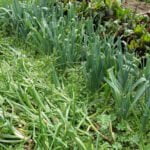Are you interested in starting a vegetable garden, but think you don’t have enough space? In this article, we will explore vegetable gardening ideas for small spaces, proving that limited areas like balconies, patios, and small gardens can still be perfect for growing your own fresh produce.
Even in small spaces, there are numerous benefits to planting vegetables. From providing easy access to fresh and organic produce to adding beauty and greenery to your surroundings, the advantages of vegetable gardening in limited areas are plentiful. With the right techniques and strategies, anyone can enjoy the satisfaction of growing their own food, no matter how small their space may be.
We will delve into various methods such as container gardening and vertical gardening to showcase how space should not limit your ability to grow vegetables. We will also offer advice on choosing the right vegetables for small spaces and discuss space-saving techniques to maximize your yield.
Additionally, practical tips on maintenance and care for your vegetable garden in a limited area will also be provided. So let’s get started on exploring the possibilities of vegetable gardening even in the smallest of spaces.
Benefits of Vegetable Gardening in Small Spaces
Small space vegetable gardening can be a rewarding and fulfilling experience, even for those who live in urban areas with limited outdoor space. Many people assume that only large plots of land are suitable for growing vegetables, but the truth is that with the right techniques and creativity, anyone can enjoy the benefits of homegrown produce, regardless of their living situation.
In this section, we will explore the numerous advantages of planting vegetables in small areas such as balconies, patios, and small gardens.
One of the primary benefits of vegetable gardening in small spaces is the ability to have fresh, organic produce right at your fingertips. By growing your own vegetables, you can reduce your reliance on store-bought produce, which often has to travel long distances before it reaches your plate. This not only ensures that you are consuming healthy and nutritious foods but also allows you to reduce your carbon footprint and contribute to a more sustainable environment.
Another advantage of small space vegetable gardening is the opportunity to maximize unused or underutilized areas in your home. Balconies, patios, and even windowsills can be transformed into bountiful vegetable gardens with a bit of creativity and resourcefulness. Additionally, many people find that tending to a small garden provides them with a sense of tranquility and relaxation, making it an ideal hobby for those looking to escape the stresses of daily life.
Furthermore, planting vegetables in small spaces offers individuals the chance to connect with nature and gain a deeper understanding of where their food comes from. By witnessing the growth process firsthand – from seedling to harvest – gardeners develop a newfound appreciation for the time and effort that goes into producing fresh fruits and vegetables. This knowledge often leads to healthier eating habits and a greater willingness to experiment with new recipes using homegrown ingredients.
| Advantages | Explanation |
|---|---|
| Fresh Produce | Reducing reliance on store-bought produce |
| Maximizing Space | Transforming unused areas into bountiful gardens |
| Nature Connection | Understanding where food comes from and fostering healthier eating habits |
Container Gardening
One key tip for maximizing space in container gardening is to select compact or dwarf varieties of vegetables. These plants take up less space while still producing a bountiful harvest. Additionally, vertical gardening techniques can be implemented within containers by using trellises or stakes to support vining crops such as tomatoes, cucumbers, and peas. This not only saves ground space but also adds visual interest to the garden.
Another way to maximize space in container gardening is by utilizing tiered plant stands or shelving units. This allows for multiple layers of plants without taking up additional floor space. Additionally, using hanging planters can be an effective way to add greenery and produce without using any ground square footage. Overall, container gardening provides endless possibilities for growing vegetables in small spaces.
| Container Types | Tips for Maximizing Space |
|---|---|
| Pots | Choose compact varieties of vegetables; use vertical gardening techniques like trellises |
| Planter Boxes | Select shallow-rooted vegetables; utilize tiered plant stands or shelves |
| Hanging Baskets | Grow trailing or cascading vegetables; position baskets at different heights to maximize vertical space |
Vertical Gardening
Understanding Vertical Gardening
Vertical gardening is a great way to maximize space in small areas and can be done using trellises, stakes, shelves, or hanging planters. This technique not only saves space but also adds visual interest to your small garden. By growing vegetables vertically, you can make the most of limited space while still enjoying a bountiful harvest.
Creating a Vertical Garden
To start vertical gardening in your small space, first assess the amount of sunlight your designated area receives. Once you’ve determined the best location for your vertical garden, choose the appropriate structure for your plants. For climbing vegetables like tomatoes, cucumbers, and beans, sturdy trellises or cages are essential for providing support as they grow upward. For smaller herbs and lettuces, consider utilizing hanging planters or tiered shelving to take advantage of vertical space.
Maintenance Tips for Vertical Gardens
When growing vegetables in a vertical garden, it’s vital to provide proper care and maintenance to ensure a successful harvest. Regular watering is crucial as plants grown vertically may dry out faster than those planted directly in the ground due to increased exposure to air and sunlight. Additionally, regular fertilization and pruning can help keep your vertical garden thriving.
By exploring the concept of vertical gardening and implementing these step-by-step instructions on how to create a vertical garden in small spaces, you can enjoy a flourishing vegetable garden without sacrificing valuable square footage.
Choosing the Right Vegetables
When it comes to vegetable gardening ideas for small spaces, choosing the right vegetables is crucial to ensure a successful and bountiful harvest. Fortunately, there are plenty of options that thrive in limited areas such as balconies, patios, and small gardens. By selecting the best vegetables for your specific space, you can maximize your yield and enjoy the benefits of homegrown produce.
Here are some vegetable options that thrive in small spaces:
- Tomatoes: Compact varieties such as cherry or determinate tomatoes are perfect for small spaces. They can be grown in pots or hanging baskets and still produce an abundant crop.
- Peppers: Both hot and sweet peppers can be grown in containers or small garden beds. Look for dwarf pepper varieties that are well-suited for limited space.
- Lettuce: This leafy green thrives in shallow containers and can be easily grown on balconies or patios. Consider planting a variety of lettuces for a colorful and nutritious salad mix.
When selecting vegetables for your small space garden, consider the following factors:
- Size and Growth Habit: Opt for compact or dwarf varieties that are well-suited for container gardening or vertical growing.
- Sunlight Requirements: Make sure to choose vegetables that match the amount of sunlight available in your specific area, whether it’s full sun, partial shade, or filtered light.
- Yield and Harvest Time: Select vegetables that have a high yield and shorter harvest time to make the most of your limited space.
By carefully choosing the right vegetables for your small space garden, you can create a productive and thriving vegetable patch no matter how constrained your area may be. With the right selection and proper care, you’ll soon be enjoying a bountiful harvest of fresh, homegrown produce right at your doorstep.
Space-Saving Techniques
When it comes to vegetable gardening ideas for small spaces, maximizing every inch of available area is crucial. Fortunately, there are several space-saving techniques that can help you make the most of your limited gardening space. Whether you have a small balcony, patio, or backyard, these techniques can help you grow a bountiful harvest of fresh vegetables.
Square Foot Gardening
One popular space-saving technique is square foot gardening. This method involves dividing your growing area into small square sections and planting different vegetables in each section. By utilizing this technique, you can efficiently use the available space while also making it easier to manage and maintain your garden.
Intercropping
Intercropping is another great technique for small-space vegetable gardening. This method involves planting different types of vegetables together in the same area. By carefully selecting compatible plants that have different growth habits and nutritional needs, you can maximize the yield from your garden while also preventing soil depletion and minimizing pest problems.
Companion Planting
Companion planting is a time-tested technique that involves planting certain vegetables together to provide mutual benefits. For example, some plants can repel pests that may damage other vegetables in your garden, while others can attract beneficial insects or improve soil health. By incorporating companion planting into your small-space vegetable garden, you can create a more harmonious and productive growing environment.
By employing these space-saving techniques in your vegetable garden, you can overcome the challenges of limited space and enjoy a successful harvest of homegrown produce. With careful planning and execution, even the smallest gardening areas can yield an abundance of fresh, flavorful vegetables.
Maintenance and Care
When it comes to vegetable gardening ideas for small spaces, maintenance and care are crucial aspects to consider in order to ensure the success of your garden. In a limited space, proper care and attention to your vegetable plants can make a significant difference in their growth and productivity. From watering and fertilizing to pest control, here are some practical tips on how to care for your vegetable garden in a small space.
Watering
In small-space vegetable gardening, proper watering is essential for the health and growth of your plants. Since containers and vertical gardens may dry out more quickly than traditional garden beds, it’s important to monitor the moisture level of the soil regularly. Consider using self-watering containers or install drip irrigation systems to ensure consistent hydration for your vegetables. Water in the early morning or late evening when temperatures are cooler to minimize evaporation.
Fertilizing
To provide essential nutrients for your vegetable plants, fertilizing is an important aspect of caring for your garden. Utilize organic fertilizers or compost to enrich the soil and promote healthy growth. For container gardens, consider using slow-release fertilizers or liquid fertilizers that can be diluted with water. Be mindful not to over-fertilize, as this can lead to excessive foliage growth at the expense of fruit production.
Pest Control
In a small space, pest infestations can pose a significant threat to your vegetable garden. Implement integrated pest management techniques such as inspecting plants regularly for signs of pests, handpicking larger insects, and utilizing natural predators like ladybugs or lacewings instead of chemical pesticides. Additionally, companion planting certain herbs and flowers can help deter pests from targeting your vegetables.
By paying close attention to watering, fertilizing, and pest control in your small-space vegetable garden, you can ensure the health and productivity of your plants. With these practical care tips in mind, you can enjoy bountiful harvests of homegrown vegetables even within limited spaces such as balconies or patios.
Harvesting and Enjoying the Fruits of Your Labor
In conclusion, vegetable gardening in small spaces is a rewarding and fruitful experience. Despite the limitations of space, there are numerous benefits to growing your own vegetables in balconies, patios, and small gardens. By embracing container gardening and vertical gardening, individuals can maximize their space and still enjoy a bountiful harvest of fresh produce.
Furthermore, choosing the right vegetables for small spaces is essential for success. By selecting compact varieties and utilizing space-saving techniques such as square foot gardening and intercropping, gardeners can optimize their yield. Additionally, proper maintenance and care, including watering, fertilizing, and pest control, are crucial for ensuring the health of the vegetable garden.
Ultimately, the joy of harvesting homegrown vegetables is unmatched. Whether enjoying fresh produce straight from the garden or preserving the harvest through canning or pickling, individuals in small spaces can savor the fruits of their labor. With a little creativity and dedication, vegetable gardening in limited areas can be a fulfilling and enriching endeavor that provides an abundance of fresh and nutritious food.

If you’re looking to get into vegetable gardening, or are just looking for some tips on how to make your current garden better, then you’ve come to the right place! My name is Ethel and I have been gardening for years. In this blog, I’m going to share with you some of my best tips on how to create a successful vegetable garden.





